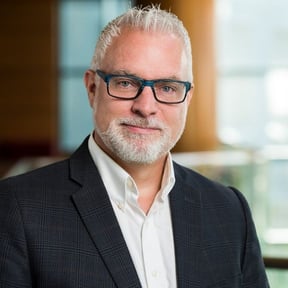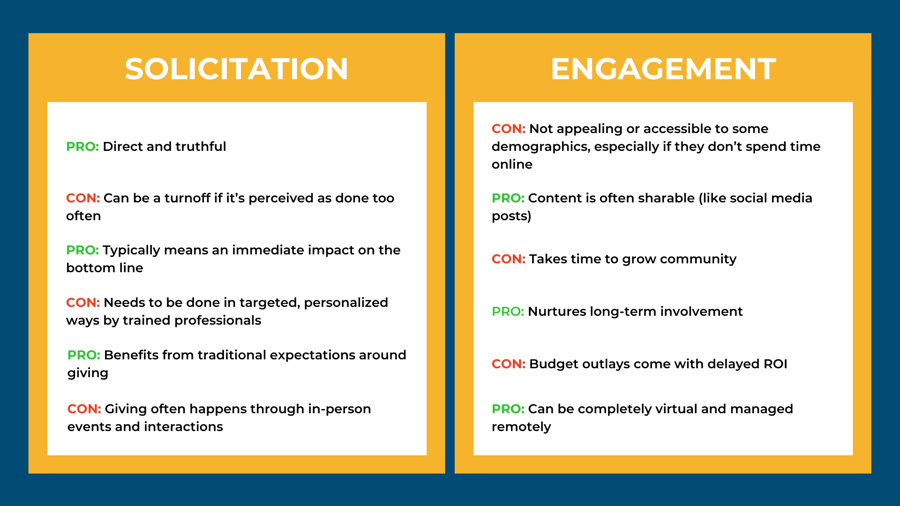Ask or Engage?
Best Practices For the
Future of Fundraising in Higher Education

The great higher education fundraising debate: Should you focus on soliciting gifts or engaging donors?
There are many strategies for fundraising, but they come down to two main types: soliciting gifts versus engaging current and potential donors. Either way, fundraising effectively is all about how you ask or engage and how often — ultimately, about the experience you create for the people who support your organization. But the question remains: Should you ask for money or connect and then slowly inspire potential donors to get involved?
Spoiler alert: The answer isn’t one or the other. It’s a bit of both.
The specific actions you take depend on your goals and how best to reach them.
No matter whether your organization is a charitable nonprofit or an institution of higher education, chances are you’re already doing both. You may be reaching out to donors and/or alumni via phone, text messages, email, social media, in-person events, or online events. Which channels are best for which purposes, and why?
“Whatever path you take, your message has to be compelling. You have to think about the reason that you’re doing this and how you can make your message better,” says Lucy Thomas, a higher-ed fundraising specialist at VanillaSoft.
We invited Louis Diez, Executive Director of Annual Giving at Muhlenberg College, to join Lucy and VanillaSoft CRO Darryl Praill for a conversation about best practices for fundraising today.
Download to Read Later

Louis Diez
Executive Director of Annual Giving,
Muhlenberg College
Louis Diez is an expert in annual fund development, digital fundraising, and engagement strategies. He currently serves as the Executive Director of Annual Giving at Muhlenberg College and hosts the Donor Participation Project.

Hosted by: Darryl Praill
CMO
Agorapulse
Darryl is a 2020 Top 10 SaaS Branding Expert. He was voted a Top 3 Marketer and a Top 32 Sales Leader on LinkedIn.

Lucy Thomas
Business Development Representative,
VanillaSoft
Lucy Thomas is a Business Development Representative with VanillaSoft. She is the former Assistant Director of Annual Giving at St. Mary’s College in Indiana, where she oversaw the telephone annual giving program.
Why not solicit donations?
Thinking about fundraising as an either-or proposition can be limiting, says Louis. Even the models of engagement we’ve been using for years may now seem “a little bit transactional,” he explains.
Over the past few years, his philosophy has evolved to think of engagement as fundamentally about community and community building.
“I think that makes a lot more sense,” Louis adds. In fact, he suggests replacing the term engagement with community instead — a “more expansive, more holistic way to look at it.”
He’s talking about an approach that’s way beyond sending three “nice” emails for every ask.
 And if you think of “engagement” as parties, dinners and fashion shows — or that money is a taboo topic you can’t talk about with your constituents — think again. Engagement can be purposeful, feel good for everyone and help your organization’s bottom line.
And if you think of “engagement” as parties, dinners and fashion shows — or that money is a taboo topic you can’t talk about with your constituents — think again. Engagement can be purposeful, feel good for everyone and help your organization’s bottom line.
At its core, this approach is focused on building loyalty and cultivating emotional investment rather than explicitly asking for money.
Subtlety and storytelling
Louis often hears from volunteers who say they want to help but don’t want to be asked to fundraise themselves. That’s not what development folks want to hear, but there are lots of ways to benefit the bottom line without directly asking for money.
You can recognize people for their time. You can invite people to in-person or online events that have a fundraising purpose. You can publish honor roll lists, share donors’ stories, and do other things that elevate those who give but encourage others to do so without asking outright.
For Lucy, storytelling done well is the way to draw people in, whether or not you ask for money. It’s the best way to tug on their heartstrings, appeal to their benevolent nature, and spread goodwill.
The power of the ask
“I spoke with a potential donor once who was in insurance at a high level, who was amazingly successful,” Louis recalls. “He told me: Insurance is something that’s sold, not bought.”
That’s why “gifts need to be asked for,” he says.
Intention and anticipation 
Sometimes asking is expected.
Let’s say you’re invited to a charity ball. There’s a band, glittering decor, a fabulous meal, and great networking opportunities. But at some point in the night, someone comes up to the microphone and makes an ask, whether it’s urging you to participate in a silent auction or write a check. Everybody goes there knowing there’s an expectation to donate, and that the organization needs to ask for money to succeed and grow.
Don’t be surprised if people in certain demographics want to give even if they’re not asked right away. Older donors, in particular, might not understand or respond to “engagement” for the sake of it. Sometimes fundraisers will reach out to them and they’ll immediately respond with a donation, even if they’re not asked for one.
Younger alums tend to be a perennial target for higher-ed development teams, but older alums are the ones who give the most recurring gifts. They’re not always involved in community activities, especially on digital platforms. But it depends — sometimes they are, and it’s incredibly powerful.
Your budget should reflect your needs
The irony is that in order to create community, your organization will need to invest some of its budget in events and other engagement strategies. Smaller organizations may struggle with fundraising on both “solicitation” and “engagement” tracks. Plus, building a community takes time and it requires will.
Sometimes nonprofits and other institutions “really just want to be able to make enough money to run the programs they need to run,” says Lucy. “For them, digital engagement means blasting out big asks over all these different channels and whichever one hits, that will be the one they use.”
Think holistically
You’ve probably realized by now that fundraising isn’t an either-or proposition. A comprehensive, both-and approach is the best way to go. Like recurring gifts from valued donors, recurring interactions with those yet to give are crucial.
But there’s power in reaching out with purpose.
“When it comes to soliciting and actually saying, We need this, you are explicitly putting your intention out there and being honest,” Lucy says. “It’s all about how you phrase it, though.”
What is digital engagement?
Digital engagement is the next-generation, strategy-driven approach to donor outreach. It encompasses traditional channels like phone calls and direct mail with social media, videos embedded in emails, SMS messages, and other digital platforms.
 Louis shares a framework for digital engagement based on his experience as a fundraiser and collaboration with the Donor Participation Project:
Louis shares a framework for digital engagement based on his experience as a fundraiser and collaboration with the Donor Participation Project:
Participatory: Communities spring up whenever people come together to participate in something. This is particularly important in the digital realm, “so you’re not talking at people,” Louis says. Everyone should have a chance to weigh in.
Purposeful: Uniting to support a cause gives everyone a common purpose. Communications from your organization should always have relevance to your community of constituents.
Recurring: You can’t build community-based on one-off communications. Meaningful engagement, digital or otherwise, happens on a regular basis. Think about communities like church groups that meet every week or college alums who keep in touch on social media but meet in person at least once a year for a reunion or a homecoming game. These kinds of connections create habits and expectations. Once you’re rooted in a group, “it starts to become a part of you,” says Louis.
Identifying leaders: Communities need vision and leadership. Look for people who step up when you ask for help or who are always willing to make a gift. Enlist them to share your mission and boost others’ efforts as well.
Community keeps people involved
The importance of community isn’t just anecdotal; it’s backed up by research.
Louis describes a Donor Participation Project study by Angie Thurston, a researcher at Harvard University. Thurston investigated why some people, especially millennials, took part in organizations — not necessarily religious congregations or nonprofits, but things like CrossFit gyms and other groups.
“It was that sense of community that really drew people in,” he says. “She heard time and time again: I came in for the workout (or the dinner or the artistic creation), but I stayed for the community. That’s engagement. That’s keeping people. That’s donor retention — all the things we’re worried about so much and struggling to achieve.”
A CTA is a must
There’s always an appropriate call to action, a best next step for the person you want to reach — for the medium you’re using to communicate with them, and at the stage of the relationship they’re in with your organization. It should be nuanced and relevant.
For example, a social media post — great for engagement — needs a CTA, but it’s probably not “make a gift.” Posts like those “tend to tank,” says Louis. “It’s probably ‘RSVP for this event’ or ‘attend this webinar.’”
But if you’re on the phone with somebody and you’ve had a great conversation, an appropriate call to action might be the question, Will you make a gift?
“When the rubber hits the road, there’s no substitute for a phone conversation,” Louis notes.
In any case, the “ask” can’t be the only thing you’re focused on. Expectation goes both ways: Many people who engage in a community want their involvement to be more than just writing checks.
Play the long game
COVID-19 created challenges we never knew we’d face. But in some ways, the pandemic has generated new ways of building community that will last far into the future.
“It’s changed fundraising forever,” says Lucy. “The long game is being adaptive, no matter what you’re doing.”
Embrace change
If you don’t ask or engage, you’ll never see results.
And you can’t expect different results if you are doing the same things you’ve always done. If you are struggling, if you’re in a rut, change it up. If somebody says no, push back.
“That’s something that I wish I’d done more,” Lucy adds. “And I feel like it’s something that in fundraising, and particularly in higher ed, we don’t do enough. It’s changing. It’s getting better. People are bringing new ideas to the table, but the reality is, it has to move forward even more.”
So get ready to discover new ideas and target the strategies you learn toward achieving your bottom-line goals. Make sure to add additional ones to your repertoire as you gain a better understanding of holistic fundraising and donor outreach. What kinds of experiences will resonate with them? Create your campaigns and your ongoing communications with their tastes and preferences in mind.
Manage expectations
As higher education fundraising professionals, we all have goals and we run campaigns. But some of the tactics here — like creating a stronger community online, developing rapport with its members, and sharing knowledge with other development teams — don’t have an immediate impact on giving. They take time and sometimes money, too.
You need to proactively convey and manage expectations with all the stakeholders involved. If you’re going with a two-pronged approach (traditional giving along with a ramped-up digital engagement campaign, for example), tell them up front. Let them know you won’t expect ROI for six months (or 18 months, if that’s the case). But explain the long-term expectation that, in aggregate, it will generate better results than traditional tactics. Make sure they understand the timeline.
Go old-school
At Muhlenberg College, Louis sees impressive results with a fairly traditional, low-tech approach. He set up a Google group listserv for every graduating class of alumni.
“They [alums] were saying, you’re only telling us things; you’re blasting things at us,” he recalls. “Well, let’s give you an environment so you can interact with each other.”
As a bonus, the listserv has a learning curve of approximately zero. There can be a lot of resistance to new platforms, but email is about as easy as it can get — and is accessible to almost everyone for free.
Louis says that as the end of the fiscal year hit, his team posted an honor roll of donors — also quite a traditional fundraising tactic — but among the small listserv community, it worked better than ever.
Find your people
Fundraising can often feel like dogma, but it’s important to pressure-test ideas, to question customs, to be open to conversations. If that’s not the case in your current job, “stand up for yourself,” says Louis. “Believe in yourself and trust yourself.”
If you can, you might try to find an environment where innovation and long-term thinking are celebrated. At the very least, look for networking opportunities that offer you that support.
The Donor Participation Project offers that kind of space.
“The back and forth is great,” Louis reports. “It’s very participatory. Just yesterday we had a session and somebody said, I love that we weren’t talked at. It was a real conversation.”

Change is good — and inevitable
At VanillaSoft, we make tools for people who sell, whether that’s selling software, insurance or the idea of making a gift to a nonprofit organization.
Selling has changed over the last few years. Historically, it was a lot like “Glengarry Glen Ross”: You’ve got to make 100 dials a day — sheer numbers were the formula for success. Now, sales reps are still expected to make daily calls (maybe 50), but they’re also expected to become involved in communities of business leaders and prospects. They’re expected to make content. They’re expected to contribute to thought leadership, engage in thought leadership, and book public speaking gigs.
And they’re expected to be supportive of one another. That’s what builds trust and relationships, so when they do the nitty-gritty work of selling, they’re more likely to seal the deal. When buyers trust, respect, and value the input of a salesperson, they’re eager to do business with them.
It’s not surprising that philanthropy is undergoing a similar transition. We’re seeing it in other industries too. But there is still discord among traditionalists who think digital engagement and community building is bunk; that it’s a distraction that gets in the way of selling. Many others see it as everything. There’s a range of opinions and no one-size-fits-all answer.
So whatever you’re working towards in your fundraising journey, you’re not alone. We all need support to move forward in today’s dynamic world, and we invite you to join in the conversation.